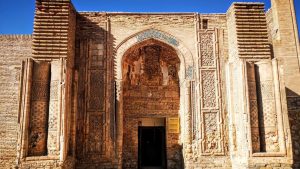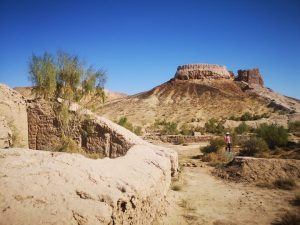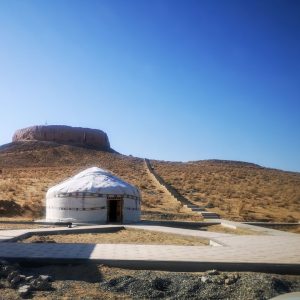
Still, I was in search of something more, something concrete, something material.
Last October, I walked on the trail of emperors.
Like most ogle-eyed tourists, I ping-ponged my way through different cities in Uzbekistan: Samarkand, Bokhara, Khiva, Nukus, Urgench, Margilon, Tashkent, Termez, Andijan, and Kokhand. Unlike most tourists, though, I was here to quench my curiosity for a long-vanquished empire—Uzbekistan is amongst the richest source of Zoroastrian history in the world. But as an Indian Zoroastrian myself, I was also drawn to something deeper.
I traveled to Uzbekistan with my parents, for a wobbly retracing of the steps blazed by Zoroastrian Emperors, to pencil in the map of my community, to thicken it with our half-remembered histories, and to grapple with the protean contours of my disbelief and my faith. My mother and father are staunch believers, and I looked to bend the light from our visit through their prisms. My knowledge of my religion was more academic, less experiential—on this trip, I hoped to surrender fully to both. And if I could gentle my distracted mind, I hoped to map these strides on paper. As a writer, words have always made a reality of my life.
Uzbekistan’s storied past is full with tales of the Silk Road. But its bedrock lies on the shoulders of three mighty Zoroastrian empires—the Parthian, the Sassanian and the mightiest of all, the Achaemenian empire—perhaps the first superpower the world has ever seen.
Karakalpakstan, a semi-autonomous region within Uzbekistan once home to a legion of Zoroastrian emperors, was like nowhere I had been. I’m used to the clash and clangour of my home city, Mumbai, a sweltering, trafficked bedlam of apartments, shanty towns, colonial architecture, temples, mosques, museums, itinerant workers, Bollywood film stars, office workers. But here, my parents and I found ourselves at Chilpik, a 2,200-year-old hollow tower steepled over the fallow sand-lands of Karakalpakstan where the only sound was the whoosh of the winds. This was the most poignant of all these days spent tunnelling through these flatlands, tracking down vestiges of my religion, walking, and leaving plumes of sandsmoke in my wake.
There isn’t much material available that can summon up even a flickering memory of the cockcrow of my religion. But if we jigsaw together what we have, this is what we find: a prophet Zoroaster, if he existed, lived and preached approximately 3,500 years ago in parts of what is now Uzbekistan, Afghanistan, Turkmenistan, and Pakistan. The religion he spread, Zoroastrianism: one of the world’s first monotheistic religions, a religion that saw divinity reflected in the purity of the earth, and most of all in fire. Its followers pray in what are known as fire temples, prostrating themselves in front of an ever-burning fire.
Years later, the religion reached its zenith under the visionary Iranian emperor Cyrus the Great (559–c. 529 BCE) who founded the Achaemenian empire, and championed what was likely the world’s first liberal, pluralistic society. At one time, the Zoroastrian empire extended from Macedonia and Libya to the Beas River in the west and from the Caucasus Mountains and the Aral Sea in the north and to the Persian Gulf and the Arabian Desert in the south (this included wide swathes of what is now Iran, Uzbekistan, stretching from present-day Bulgaria and Romania to Egypt). In the 7th century CE, Arab armies came and conquered, converting people to Islam. Still, Zoroastrianism survived, as some people banded together and new rulers arose. In the 13th century, Genghis Khan razed cities in Uzbekistan, massacring the population and igniting the collapse of a civilization that had once stretched all the way to Iran.
What remains today are ruins, squiggled across desert and cotton fields. Amidst the melee, a small, determined group of survivors set sail from Iran, plashing across the ocean in storm-tossed boats, carrying the freight of a dying religion with them, until they found refuge in India. They came to be known as the Parsis.

This is who I am, a Parsi.
We are a pinprick amongst India’s kaleidoscope of spirituality and religion. A gently evanescing people, we are known best for three things—our food (a roving palate that melds together an Iranian love of meat, eggs and dried fruit, coconut and seafood, through proximity to the western Indian coast, the custards and sauces of the colonial English, vinegar and potatoes from the Portuguese, and baked goods thanks to the Dutch colonies that intruded into Gujarat), our (past) contributions to India’s cultural and economic landscape, and our falling birth rates. There are no more than 70,000 of us today in the world. So much of our history is bound up in faraway lands.
Perhaps at heart, then, our trip and its urgency was spun from this sense of loss—a sort of cultural salvage for a vanishing people that once held powerful positions in India’s political, business, and cultural industries in the 18th and 19th centuries.
In Uzbekistan, where Islam is the dominant religion, I expected to feel even further marginalized. Yet, everywhere I went, Zoroastrianism still inhabited the land. A twisted version of the Asho Farohar, sacred winged symbol of my people, chiseled into the pillars of the caravan town, Khiva. I even saw one on a sticker striped onto the back of a car in Samarkand. In Bokhara, I shouldered my way into the crowded Hazrat Hizr mosque that was once a Zoroastrian fire temple—the altar remains even today. A carpet seller in Samarkand thrilled at the sight of my father’s religious white muslin vest and told us that there is a gentle resurgence of people turning secretly to the leftover faith of their ancestors. On March 21, Uzbekistan, Iran, and the few Parsis of the world unite to celebrate a relic of Zoroastrianism, the spring festival of Navroze or Norooz.
In Mumbai, I was a Zoroastrian, yes, who bent her head at fire temples on her birthday and Navroze, kept a divo (oil lamp) burning day and night, lit sticks of incense in the gloaming, stamped auspicious chalk patterns on to my floor, and cooked Parsi food the way my mother taught me. But mostly, I was islanded by city living. My days were trussed up by deadlines and appointments, laundry and bills—that is, the paraphernalia of everyday life.
Here, though, unearthing these vestiges of Zoroastrianism, I found the hooks to hang my memories on. Still, I was in search of something more, something concrete, something material.
And this is how I found myself in the sandy flatlands of Karakalpakstan, under the wind-white October bloom of Uzbekistan’s autumn sky, looking for the splintered ruins of a dead culture at its peak.
We drove through shires of sand, stretching ahead of us for miles, pimpled with great tufts of cotton plants. And then suddenly, from miles of nothing but sandlands, loomed our first palace fort. Its ribs lifting out of solitude, its grooves scratched clear as day still. It was nothing, a mere whaleback, a fossil, empty of locals and travelers. Still, even in this collapsed geometry of rock, there clung a quiet majesty.
When I stepped out of the car, the wind slanted so harshly against me that my cheeks pinked and my hair stood at right angles to my face. My father was prepared. He had studied maps. He had read books.
“This,” he said, squinting at his iPad and pointing at some rubble, “this is probably where the priests worshipped the holy fire. Archaeologists have surmised that the fire was not in a metal urn as is the case in our Indian temples but in a hearth or earth bowl.”
My parents bent down and lit a stick of incense, then muttered a prayer for generations past and present.
We drove hither and thither in an immense four-wheel drive, breasting the dunes while the sun grew ripe and hot. The days dripped by. Thanks to my father’s constant warbling, I learnt my history in great gulps of information. At Chilpik, the best preserved of all sites, my mother was awed—it was a hark back to the dokhma, the sacred Tower of Silence in Mumbai, where we had laid many friends and friends to rest. Here, tourists pattered up and down its steps, taking photographs. I felt discombobulated. I felt at home. I was not sure how I felt. This journey wore away at the armor of detachment I had long assumed when it came to my religion, an armor that cupped me through the anxiety of belonging to a tiny, dying faith in Mumbai.

Every night on this trip, when I thought about forcing my words onto a page and every night, they sat just beyond the lip of my mind and did not come. I did not write a word even when I reached Termez, our next stop that sat on the southernmost fringe of Uzbekistan; it is fenced from Afghanistan by only the Amu Darya river. In the Djurkatana museum, we found the model of a fire temple that likely existed in Zoroaster’s time. My parents were elated; they took picture after picture, while a stream of visitors eddied round them. “Zoroaster might have even seen this temple himself!” mum said, the light rushing into her face.
Their life was limned by religion. They had understood our entwined histories, felt in their hearts a narrative that bound them to millennia past and to a palely-lit museum in a nondescript city in Central Asia. But to me? It was just a model temple behind a glass case in a museum. I didn’t feel it yet.
Epiphanies are hard to come by. Maybe mine was still clawing its way toward me. If I sat still and thought very hard, it might run through me and I would lose the rootlessness that had often plagued me.
Most of the sites we visited were fascinating perhaps only to my family. But there was one other, in Samarkand-Afrosiyab, a majestic city within a city, of the Sogdian people (followers of a strain of Zoroastrianism). Like everywhere else, the ancient city itself had ossified into debris, but a small museum on Sogdiana abutted it. Within, a technicolor dream burst to life: pots and pans and the usual paraphernalia of daily living, ossuaries housing the souls of their dead, swords and coins, and a flame-whitened hearth of fire. And most magnificent of all, the frescoes that once hung on the walls of the palace: in spite of enormous gaps in the pictorium, we saw a cavalry of courtiers galloping after the once-king of Samarkand, a patter of sacrificial geese, the queen astride a gorgeously-caparisoned elephant, Chinese envoys holding out a nimbus of silken offerings. Afterwards, we watched a vivid video reproduction of Afrosiyab’s past in a darkened room.
This was a panoply of Zoroastrian empire come to life—its beliefs, its rituals, its minutiae of everyday living laid bare, perhaps the only place I’d seen it laid out quite so imposingly. If I was in search of something solid, I had found it here.
Later, I bought every single postcard that the tiny museum gift shop had to offer and burst out chattering wildly. My interest was quickened, my tongue felt loosened. But as I sat and wrote down the memories of my day, I thought of my quest to paper over the chink in my soul and realized that perhaps it was not necessary to write myself into this story.
In the cultural melee that is Mumbai, I found it easy to inhabit multiple worlds. A blessing, I think, even when it came at the cost of fencing me from a glorious past. However cliché it sounds, what Uzbekistan ultimately gifted me was a thread that bound me, however loosely, to Zoroastrianism’s glory days, a world that in my mind had been all but squashed by the rigors of my own daily life. But there were other lessons, too. The trip collapsed history into my present, widening my world beyond the modest familiarities of my home fires. I found similarity within strangeness. And, perhaps fittingly, the complete extinction of this once astounding empire had made more palpable my anxiety over the fall of my community.
But I had a chance to drink my fill of it. The epic philosophical sweepings I’d once hoped to write suddenly seemed unnecessary—I found that it was enough to carry the topography of this pilgrimage within me. It was enough for the three of us to be knotted together forever by our shared memories. It was enough.
This article was first published on https://catapult.co. June 29, 2020
